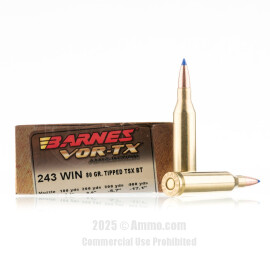
243 Ammo For Sale
Overview of 243 Ammo
In 1955, Winchester introduced the .243 for two rifles: the bolt-action Model 70 and the lever-action Model 88. Known for its efficiency, the .243 cartridge enjoys a positive reputation today, with all major American ammo manufacturers selling it in an extensive array of bullet weights and types.
Most major firearms manufacturers have at least one weapon chambered for the .243 Winchester. It’s the only 6mm cartridge that ever effectively captured the imagination of the American ammunition market.
What are the most popular 243 Win brands you sell?
You can filter our entire selection using the left sidebar to see which brands we currently have in stock and available using the Manufacturers filter. You can also filter by attributes such as Bullet Type, Bullet Weight, Casing Type, and Primer Type to find what you need.
If you're interested in target shooting, feel free to learn more about the best 243 Win ammo for it!
How Does The 243 Win Compare To Other Calibers?
| Caliber | Recoil | Pros | Cons |
|---|---|---|---|
| 270 Winchester | 243 Win has less | 243 Win has less recoil, better for varmint hunting, and flatter short-range trajectory | 243 Win has less stopping power and worse long-range trajectory |
| 308 Winchester | 243 Win has less | 243 Win has less recoil and flatter short-range trajectory | 243 Win has less stopping power and worse long-range trajectory |
| 6.5 Creedmoor | 243 Win has less | 243 Win has less recoil and flatter short-range trajectory | 243 Win has less stopping power and worse long-range trajectory |
| 6mm Remington | Virtually identical | 243 Win has less expensive and easier to find ammo | None |
| 6mm ARC | 243 Win has slightly more | 243 Win has flatter trajectory and more ammo options | 243 Win has lower BC bullets and slightly less stopping power |
You can also check out our in-depth look at 243 ballistics from all of the popular ammo manufacturers if you're searching for ballistics data for your favorite factory 243 load.
Customer Reviews
-
Mr. Jimmy said:
Five deer taken on my ranch with this ammo: two neck shots, two head shots, and one shoulder shot ( 106 yds) . All dropped in their tracks! The shoulder shot hit a rib but still exited the body with a one inch exit wound that would have facilitated tracking, had it been necessary.
-
Jimmy said:
My friends and family have taken five deer from my ranch this season, all taken with this ammo. All dropped in their tracks! Two were heart/lung shots, two were neck shots, and one head shot. Both chest area shots penetrated completely with minimal meat damage and left a quarter size exit which would have left a good blood trail if tracking had been necessary. Tremendous performance!
-
Bamaboy said:
Punched right through 1/4 inch steel plate like hot butter. Same plate easily stops steel core .223 rounds.
-
DAVID said:
I recently purchased a new 243 Win. I bought five diferent brands of ammo. This one shot a one ragged hole group.
-
Oceanfrog said:
Tight, tight groups from my Weatherby with a 7.5” twist. Consistently less than an inch at 100 yards. If there’s a flier, I know it’s me, not the ammo.
































































































